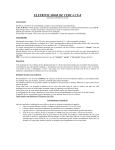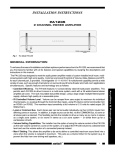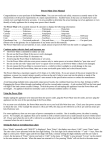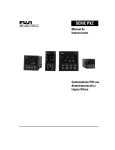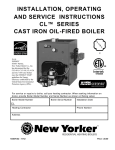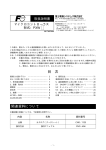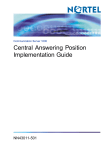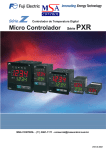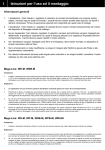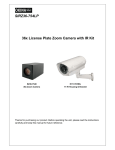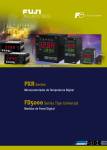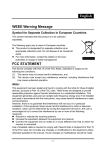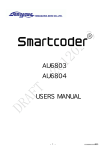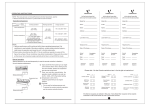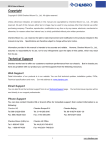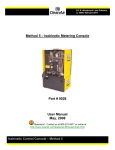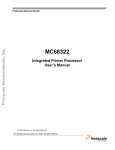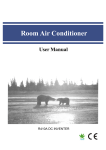Download FUS1 Controler
Transcript
PXV3/PXW SERIES Operation Manual PID Autotune Controllers Featuring Fuzzy Logic TABLE OF CONTENTS Introduction. . . . . . . . . . . . . . . . . . . . . . . . . . . . . . . . . . . . . . . . . . . . . . . . . 2 Features. . . . . . . . . . . . . . . . . . . . . . . . . . . . . . . . . . . . . . . . . . . . . . . . . . . . 2 Safety Precautions. . . . . . . . . . . . . . . . . . . . . . . . . . . . . . . . . . . . . . . . . . . 2 PXV3 Model Configuration . . . . . . . . . . . . . . . . . . . . . . . . . . . . . . . . . . . . . . . 3 Specifications. . . . . . . . . . . . . . . . . . . . . . . . . . . . . . . . . . . . . . . . . . . . . 3 Outer Dimensions and Panel Cutout Size . . . . . . . . . . . . . . . . . . . . . . 4 Installation . . . . . . . . . . . . . . . . . . . . . . . . . . . . . . . . . . . . . . . . . . . . . . . 4 Wiring Instructions: . . . . . . . . . . . . . . . . . . . . . . . . . . . . . . . . . . . . . . . 5 Front Panel Description. . . . . . . . . . . . . . . . . . . . . . . . . . . . . . . . . . . . . 5 Front Panel Operation . . . . . . . . . . . . . . . . . . . . . . . . . . . . . . . . . . . . . . 5 PXW Model Configuration . . . . . . . . . . . . . . . . . . . . . . . . . . . . . . . . . . . . . . . 6 Specifications. . . . . . . . . . . . . . . . . . . . . . . . . . . . . . . . . . . . . . . . . . . . . 6 Outer Dimensions and Panel Cutout Size . . . . . . . . . . . . . . . . . . . . . . 8 Installation . . . . . . . . . . . . . . . . . . . . . . . . . . . . . . . . . . . . . . . . . . . . . . . 8 Wiring Instructions: . . . . . . . . . . . . . . . . . . . . . . . . . . . . . . . . . . . . . . . 9 Front Panel Description. . . . . . . . . . . . . . . . . . . . . . . . . . . . . . . . . . . . 10 System Wiring Diagrams. . . . . . . . . . . . . . . . . . . . . . . . . . . . . . . . . . . 10 Front Panel Operation . . . . . . . . . . . . . . . . . . . . . . . . . . . . . . . . . . . . . 11 Autotuning. . . . . . . . . . . . . . . . . . . . . . . . . . . . . . . . . . . . . . . . . . . . . . . . . 11 Programming Primary Menu . . . . . . . . . . . . . . . . . . . . . . . . . . . . . . . . . . . . . . . . . . . . 11 Secondary Menu. . . . . . . . . . . . . . . . . . . . . . . . . . . . . . . . . . . . . . . . . . 12 Factory Preset Menu . . . . . . . . . . . . . . . . . . . . . . . . . . . . . . . . . . . . . . 16 Error Messages . . . . . . . . . . . . . . . . . . . . . . . . . . . . . . . . . . . . . . . . . . . . 18 Appendix A: Autotuning. . . . . . . . . . . . . . . . . . . . . . . . . . . . . . . . . . . . . . 18 Appendix B: Manual Tuning . . . . . . . . . . . . . . . . . . . . . . . . . . . . . . . . . . 19 Appendix C: Heater Break Option. . . . . . . . . . . . . . . . . . . . . . . . . . . . . . 21 Appendix D: Heat/Cool Option. . . . . . . . . . . . . . . . . . . . . . . . . . . . . . . . . 22 Quick Reference . . . . . . . . . . . . . . . . . . . . . . . . . . . . . . . . . . . . . . . . . . . . 24 Free Technical Support: 1-800-884-4967 U.S. & CANADA 802-863-0085 INT’L 802-863-1193 Fax 8:30 A.M.- 6:00 P.M. E.S.T. V298.8 1 INTRODUCTION • UL, C-UL, and CE approvals • 3-year warranty Thank you for purchasing the Fuji Electric temperature/process controller. All of these controllers are PID Autotune controllers that employ Fuji Electric’s patented fuzzy logic algorithms. SAFETY PRECAUTIONS It is a fully programmable temperature/process controller incorporating many user-friendly features. The following easy-to-use instructions are intended to help you understand, set up, effectively operate, and achieve optimal performance from your controller. When programmed and operated within the guidelines set up for them in this manual, your controller will give you years of precise, reliable control. If needed, we will provide free technical support throughout the life of the controller. The first section of this manual details the specifications and general description for the PXV3 controller. The second section will cover the PXW controller, followed by a detailed description of the programming parameters, which are common to both the controllers. Several appendices describe some of the controlling techniques. Finally, a Quick Reference guide gives a listing of all the parameters and their default values. FEATURES • Fuzzy Logic Control • PID Autotune with manual override - heating or cooling • Programmable control action - reverse or direct • Programmable cycle time • Programmable inputs - Thermocouple/ RTD, Current/ Voltage • Sensor burn-out protection • Input calibration by user • Outputs: Relay, Solid-state relay drive, or 4-20mA DC (4-20mA not available on PXV3) • Secondary output for cooling (optional) • High/low alarm outputs (optional) • Heater break alarm (optional) (only on PXW 5,7,9) • Menu driven format • Setting – touch keys on front panel • Programmable 8-segment ramp/soak function • Digital filtering (to suppress factory noise) • Adjustable setpoint range • Selectable °F/°C • Offset adjustments • Programmable decimal point • Programmable lock feature • Advanced security options to prevent unauthorized parameter changes • 4-digit, LED indication • Output status indication • Fault indication • Non-volatile memory • 1/32, 1/16, 1/8, 1/4 DIN and 72mm panel mount package • NEMA 4X faceplate • ABS plastic housing • Termination— screw-down type (PXV3, PXW-5, 7, 9) or socket with screw-down terminals (PXW-4) • Metal mounting bracket; plastic bracket for PXV3/PXW-4 • 85 to 264V AC free voltage power supply • 24V AC/DC power supply (optional) Before using this product, the user is requested to read the following precautions carefully to ensure safety. The safety requirements are classified as either “warning” or “caution” according to the following explanations: Warning suggesting that the user's mishandling can result in personal death or serious injury. Caution suggesting that the user's mishandling can result in personal injury or damage to the property. Warning Wiring 1. If there is danger of serious accident resulting from a failure or defect in this unit, provide the unit with an appropriate external protective circuit to prevent an accident. 2. The unit is normally supplied without a power switch or a fuse. Use power switch and fuse as required (Rating of the fuse: 250V, 1A) Power supply 1. Be sure to use the rated power supply voltage to protect the unit against damage and to prevent failure. 2. Keep the power off until all of the wiring is completed so that electric shock and trouble with the unit can be prevented. General 1. Never attempt to disassemble, modify, or repair this unit. Tampering with the unit may result in malfunction, electric shock, or fire. 2. Do not use the unit in combustible or explosive gaseous atmospheres. Caution Installation 1. Avoid installing the unit in places where: • the ambient temperature may reach beyond the range of -10 to 50°C (14 to 122°F) while in operation • the ambient humidity may reach higher than 90% RH while in operation • a change in the ambient temperature is so rapid as to cause condensation • corrosive gases (sulfide and ammonia gas, in particular) or combustible gases are emitted • the unit is subject to vibration or shock • the unit is likely to come in contact with water, oil, chemicals, steam, or vapor • the unit is exposed to dust, salt, or air containing iron particles • the unit is subject to interference with static electricity, magnetism, or noise • the unit is exposed to direct sunlight • heat may be accumulated due to radiation Maintenance 1. Do not use organic solvents such as alcohol or benzene to wipe this unit. Use a neutral detergent. 2. Three-year warranty is guaranteed only if the unit is properly used. PXV3 MODEL CONFIGURATION P X V 3 Type of Input Thermocouple (°C) Thermocouple (°F) RTD/Pt100 (°C) RTD/Pt100 (°F) 4-20mA DC, 1-5V DC 0-20mA DC, 0-5V DC Code T R N S B A Control Output 1 Relay contact (reverse action) Relay contact (direct action) SSR/SSC driver (reverse action) SSR/SSC driver (direct action) Code A B C D Control Output 2 None Relay contact (reverse action) Relay contact (direct action) Code Y A B Alarm Option None High/Low alarm (SPST)* *Available with single output only Code 4 5 Power Supply Option 85-264 VAC 24V AC/DC Code D CONTROL FUNCTION (SINGLE OUTPUT) ________________________________________________________ 1 Control action PID control with auto-tuning Fuzzy control with auto-tuning ________________________________________________________ Proportional band (P) 0-999.9%, of full scale (FS), setting in 0.1% steps ________________________________________________________ V Integral time (I) 0-3200 sec, setting in 1 sec steps ________________________________________________________ Differential time (D) 0-999.9 sec, setting in 0.1 sec steps ________________________________________________________ P,I,D = 0: 2-position action I,D = 0: Proportional action ________________________________________________________ Proportional cycle 1-150 sec, setting in 1 sec steps, for relay contact output and SSR/SSC drive output only ________________________________________________________ Hysteresis width 0-50% FS, setting in 1 E.U. (Engineering Unit) steps, 2-position action only ________________________________________________________ Anti-reset wind up 0-100% FS, setting in 1 E.U. steps, auto-setting with auto-tuning ________________________________________________________ Input sampling cycle 0.5 sec ________________________________________________________ Control cycle 0.5 sec ________________________________________________________ CONTROL FUNCTION (DUAL OUTPUT) (Heat/Cool Type) ________________________________________________________ Heating Proportional band P x 1/2 (P= 0-999.9%) ________________________________________________________ Cooling Proportional band Heating proportional band x Cooling proportional band coefficient Cooling proportional band coefficient= 0-100 0: 2-position action ________________________________________________________ Integral time 0-3200 sec for heating and cooling ________________________________________________________ Differential time 0-999.9 sec for heating and cooling ________________________________________________________ ________________________________________________________ P,I,D= 0: 2-position action (without dead band) for heating and cooling I,D= 0: Proportional action ________________________________________________________ PXV3 SPECIFICATIONS Proportional cycle 1-150 sec, for relay contact output and SSR/SSC drive output only ________________________________________________________ Hysteresis width 2-position action for heating and cooling: 0.5% FS 2-position action for cooling: 0.5% FS ________________________________________________________ INPUT RANGE TABLE: ________________________________________________________ Input Signal Input Range Input Range Remarks (°C) (°F) ________________________________________________________ Thermocouple J 0~800 32~1472 Cold Junction K 0~1200 32~2192 compensating R 0~1600 32~2912 function built-in B 0~1800 32~3272 S 0~1600 32~2912 T -199~200 -328~392 T -150~400 -238~752 E -199~800 -328~1472 N 0~1300 32~2372 PL2 0~1300 32~2372 ________________________________________________________ RTD Pt100 -150~850 -238~1562 Allowable wiring resistance 10 ohms Anti-reset wind-up 0-100% FS, setting in 1 E.U. steps, auto setting with auto-tuning ________________________________________________________ Overlap/dead band ±50% of heating proportional band ________________________________________________________ Input sampling cycle 0.5 sec ________________________________________________________ Control cycle 0.5 sec ________________________________________________________ OUTPUT ________________________________________________________ Relay contact output: SPST 220V AC/30V DC 2A (resistive load) Mechanical life: 107 times (under no load) Electrical life: 105 times (under the rated load) ________________________________________________________ SSR driver output: On-5V DC typ. (5.5V ±1V), 20mA max. Off-0.5V or less ________________________________________________________ Alarm output/ SPST 220V AC/ 30V DC 2A (resistive load) 2nd control output: ________________________________________________________ Alarm: Configurable from the front panel keys as Absolute, Deviation, Zone, or Combination alarms with or without the hold feature. ________________________________________________________ max (per wire) ________________________________________________________ DC Voltage/ Current 1-5V Scaling Range: -1999 to 9999 For current input, 0-5V use the 250Ω Engineering Units resistor to obtain 4-20mA 1-5V or 0-5V DC 0-20mA input ________________________________________________________ SETTING AND INDICATION ________________________________________________________ Accuracy: ± 0.5% of FS ± 1 digit ( ± 1°C for thermocouple) R T/C: 0-400°C: ±1%FS ± 1 digit ± 1°C B T/C: 0-500°C: ±5%FS ± 1 digit ± 1°C ________________________________________________________ ________________________________________________________ Setting method: 3-key operation ________________________________________________________ Indicator: 4 digit, 7-segment LED (green) ________________________________________________________ 3 OUTER DIMENSIONS & PANEL CUTOUT SIZE SELF-DIAGNOSIS ________________________________________________________ Method: Program error is monitored with a watchdog timer. ________________________________________________________ Outer Dimensions GASKET ( thickness=1mm ) PANEL 22(.87) 24.5(.97) MOUNTING BRACKET 48 (1.9) OPERATING AND STORAGE CONDITIONS ________________________________________________________ Operating temperature: -10 to 50°C (14 to 122°F) ________________________________________________________ Operating humidity: 90% RH or less (non-condensing) ________________________________________________________ Storage temperature: -20 to 60°C (-4 to 140°F) ________________________________________________________ Installation category: II ________________________________________________________ Pollution degree: 2 ________________________________________________________ 34.2(1.35) PROTECTION FROM POWER FAILURE ________________________________________________________ Memory protection: Non-volatile memory. Parameter values remain unchanged with disruption of power. Ramp/soak function has to be re-initiated. ________________________________________________________ 8 9.5 (.37) 48 (1.9) 98 (3.86) MOUNTING BRACKET Unit: mm (in.) Panel thickness: 1 to 8 mm (0.04 to 0.31) Panel Cutout GENERAL SPECIFICATIONS ________________________________________________________ Rated voltage: 85-264V AC or 24V AC/DC ________________________________________________________ 57 or more When installing “n” number of units (NEMA4X/IP66-compatible) 5VA or less (100V AC) 8VA or less (240V AC) ________________________________________________________ Insulation resistance: 20MΩ or more (500V DC) ________________________________________________________ +0.3 22.2 –0 34 or more Power consumption: +0.5 45 –0 Withstand voltage: Power source-Earth: 1500V AC, 1 min Power source-input terminal: 1500V AC, 1 min Earth-relay output: 1500V AC, 1 min Earth-Alarm output: 1500V AC, 1 min Between other terminals: 500V AC, 1 min ________________________________________________________ ________________________________________________________ Input impedance: Thermocouple: 1MΩ or more Voltage: 450KΩ or more Current: 250Ω (external resistor) ________________________________________________________ INSTALLATION Allowable signal Thermocouple: 100Ω or less source resistance: Voltage: 1KΩ or less ________________________________________________________ Allowable wiring RTD: 10Ω or less per wire resistance: ________________________________________________________ NEMA 4X Integrity The front side of this instrument conforms to NEMA 4X. To ensure the waterproofness between the instrument and the panel, use the gasket that is provided with the unit according to the installation procedure described below. 1. Install the gasket over the enclosure and insert the unit into the panel as shown in Figure 1. 2. Slide the mounting bracket and tighten the screws as shown in Figure 2. Reference junction ± 1 °C (at 23°C) compensation accuracy: ________________________________________________________ Process variable offset: ±10% FS ________________________________________________________ Setpoint variable offset: ± 50% FS ________________________________________________________ Input filter: 0-900.0 sec, setting in 0.1 sec steps (primary lagging filter) ________________________________________________________ Figure 1 Figure 2 Unit Unit Noise rejection ratio: Normal mode noise (50/60Hz): 50dB or more Common mode noise (50/60Hz): 140dB or more ________________________________________________________ STRUCTURE ________________________________________________________ Mounting method: Panel mounting ________________________________________________________ Enclosure: Plastic housing ________________________________________________________ Protection: NEMA 4X/ IEC IP66 (front panel) ________________________________________________________ External terminal: Pluggable terminal w/screw connection ________________________________________________________ External dimensions: 48 (W) x 24.5 (H) x 99 (D) [mm] ________________________________________________________ Weight: Approx. 100 g ________________________________________________________ Finish color: Black (front panel) ________________________________________________________ Bezel Gasket Case Panel Panel Mounting Bracket Screw Caution: After the mounting bracket is installed, check the gasket for displacement and detachment as shown in Figure 3. ,, ,,,,, ,,,,,,, Gasket Case DELIVERY ________________________________________________________ Controller, panel mounting bracket, waterproof gasket, 250Ω precision resistor (when necessary), instruction manual. ________________________________________________________ (Bad) 4 Gasket ,,,, ,,,, ,, ,, Figure 3 Case (Good) WIRING INSTRUCTIONS FRONT PANEL OPERATION The PXV3 controller programming menu consists of three blocks— PRIMARY (SETPOINT) MENU, SECONDARY (SYSTEM) MENU, and FACTORY PRESET MENU. At power up the controller will be in the operational mode, and process variable (PV) will be displayed. This is the variable that is being controlled, and it is not programmable. When setting the parameters, turn off the power to the load (operating equipment) to ensure safety. Since it takes 30 minutes for the unit to stabilize in terms of temperature, all measurements should be carried out at least 30 minutes after the power is turned on. Option-related features are displayed only when the options are provided. Terminal connection Warning Be sure to use the rated power supply voltage and polarity. OUTPUT1 – ALARM/ OUTPUT2 + V. PULSE INPUT 1 B 2 – B – POWER 3 4 + 5 6 7 8 – A + Viewing and Setting Parameters 9 + • The data is automatically registered in 3 seconds after the setting. It can also be registered by pressing the SEL key. How to set Setpoint value (SV) Operation Display 1. Power on. – Process value (PV) 2. Press SEL key – SV value; SV lamp is lit 3. Press UP or DOWN key – SV value changes accordingly 4. Press SEL key to go back to – Process value (PV); SV lamp off the operational mode Power supply * For current input, install the 250Ω precision resistor (accessory) before using the unit. 250Ω + – Wiring material PRIMARY (SETPOINT) MENU Operation 1. Operational Mode 2. Press SEL key for 3 seconds 1. For terminals 1, 2, 3, use 18 ~ 26 gauge wire. 2. For terminals 4 to 9, use 14 ~ 24 gauge wire. Please refer to Page 9 for further instructions on wiring power, input and output to the controller. 3. Press UP or DOWN key 4. Press SEL key to access the next parameter 5. Press SEL key for 3 secs. FRONT PANEL DESCRIPTION 2 1 OUT Display – Process value – 3 seconds later, ALM LED blinks 7 seconds later, “P” 3. Release and press SEL key again – “P” data 4. Press UP or DOWN key – “P” data changes accordingly 5. Press SEL key once – “P” 6. Press DOWN key to scroll down – “i”, “d”, ..... “Mod” the menu 7. Press SEL key for 3 secs. – Operational mode 6 ALM Åõ SEL 8 3 NAME 1 Set value (SV) indication lamp 2 Process value (PV)/ Set value (SV)/ parameter display 3 Select key 4 UP key 5 DOWN key 6 Autotuning indication lamp 7 Control output indication lamp 8 Alarm indication lamp 4 – Operational mode SECONDARY (SYSTEM) MENU Operation 1. Operational Mode 2. Press SEL key for 7 seconds SV 7 Display – Process value (PV) – ALM LED blinks; AH data (for units with alarm option) – AH data changes – AT 0, ...... 5 FUNCTION Comes on when a set value (SV) is displayed Process value (PV), Setpoint value (SV), or parameter symbols and codes are displayed. To be used when the first, second, or third block parameters are selected Pressing the key once will increase the value by one. By pressing it in succession, the value is continuously incremented. Pressing the key once will decrease the value by one. By pressing it in succession, the value is continuously decremented. Blinks while the PID autotuning is being performed FACTORY PRESET MENU Operation 1. Operational Mode 2. Press SEL key for 9 seconds Display – Process value – 3 seconds later, ALM LED blinks 7 seconds later, “P” 9 seconds later, “P-n1” 3. Release and press SEL key again – “P-n1” data 4. Press UP or DOWN key – “P-n1” data changed 5. Press SEL key – “P-n1” 6. Press DOWN key to scroll down – “P-dF”, ........ “dsp7” the menu 7. Press SEL key for 3 secs. – Setpoint value Comes on when the control output is ON Comes on when the alarm is activated. Blinks while the alarm is being set. 5 PXW SPECIFICATIONS PXW MODEL CONFIGURATION P X W Front panel size 1/16 DIN 1/8 DIN 72mm 1/4 DIN Code 4 5 7 9 Type of input Thermocouple (°C) Thermocouple (°F) RTD/Pt100 (°C) RTD/Pt100 (°F) 4-20mA DC, 1-5V DC 0-20mA DC, 0-5V DC Code T R N S B A Control Output 1 Relay contact (reverse action) Relay contact (direct action) SSR/SSC driver (reverse action) SSR/SSC driver (direct action) 4 to 20mA DC (reverse action) 4 to 20mA DC (direct action) Code A B C D E F Control Output 2* None Relay contact (reverse action) Relay contact (direct action) SSR/SSC driver (reverse action) SSR/SSC driver (direct action) 4 to 20mA DC (reverse action) 4 to 20mA DC (direct action) *not available on PXW-4 type Code Y A B C D E F 1 V INPUT RANGE TABLE: ________________________________________________________ Input Signal Input Range Input Range Remarks (°C) (°F) ________________________________________________________ Thermocouple J 0~800 32~1472 Cold Junction K 0~1200 32~2192 compensating R 0~1600 32~2912 function built-in B 0~1800 32~3272 S 0~1600 32~2912 T -199~200 -328~392 T -150~400 -238~752 E -199~800 -328~1472 N 0~1300 32~2372 PL2 0~1300 32~2372 ________________________________________________________ RTD Pt100 -150~850 -238~1562 Allowable wiring resistance 10 ohms max (per wire) ________________________________________________________ DC Voltage/ Current 1-5V Scaling Range: -1999 to 9999 For current input, use 0-5V Engineering Units the 250Ω resistor 4-20mA to obtain 1-5 V or 0-20mA 0-5V DC input ________________________________________________________ Alarm Options Code Heater break alarm* 2 Process alarm & Heater break alarm* 3 None 4 Process alarm 5 *not available on PXW-4, or with 4-20mA output Power Supply Option 24V AC/DC CONTROL FUNCTION (SINGLE OUTPUT) _________________________________________________________ Control action PID control with auto-tuning Fuzzy control with auto-tuning _________________________________________________________ Proportional band (P) 0-999.9%, of full scale (FS), setting in 0.1% steps _________________________________________________________ Code D Integral time (I) 0-3200 sec, setting in 1 sec steps _________________________________________________________ Differential time (D) 0-999.9 sec, setting in 0.1 sec steps _________________________________________________________ P,I,D = 0: 2-position action I,D = 0: Proportional action _________________________________________________________ Proportional cycle 1-150 sec, setting in 1 sec steps, for relay contact output and SSR/SSC drive output only _________________________________________________________ Hysteresis width 0-50% FS, setting in 1 E.U. (Engineering Unit) steps, 2-position action only _________________________________________________________ ACCESSORIES (Sockets: only for PXW4 and sold separately) ____________________________________________________ 8-pin sockets (for PXW-4 without H / L Alarm Option) ATX1NS Solder Type Socket PG-08 Screw-down type (terminals on back) ATX2PSB Screw-down type (terminals on back) (UL) TP28X Screw-down type (terminals on front) (UL) 11-pin sockets PG-11 TP311SB TP311S Anti-reset wind up 0-100% FS, setting in 1 E.U. steps, auto-setting with auto-tuning _________________________________________________________ Input sampling cycle 0.5 sec _________________________________________________________ (for PXW-4 with H / L Alarm Option) Screw-down type (terminals on back) Screw-down type (terminals on back) (UL) Screw-down type (terminals on front) (UL) Control cycle 0.5 sec _________________________________________________________ CONTROL FUNCTION (DUAL OUTPUT) (Heat/Cool Type) _________________________________________________________ Heater Break Current Sensing Transformer: CTL-6-SF For heater current (1 to 30 amps) CTL-12-S36-8F For heater current (20 to 50 amps) ____________________________________________________ Heating Proportional band P x 1/2 (P= 0-999.9%) _________________________________________________________ Cooling Proportional band Heating proportional band x Cooling proportional band coefficient Cooling proportional band coefficient= 0-100 0: 2-position action _________________________________________________________ Integral time 0-3200 sec for heating and cooling _________________________________________________________ Differential time 0-999.9 sec for heating and cooling _________________________________________________________ _________________________________________________________ P,I,D= 0: 2-position action (without dead band) for heating and cooling I,D= 0: Proportional action _________________________________________________________ Proportional cycle 1-150 sec, for relay contact output and SSR/SSC drive output only _________________________________________________________ Hysteresis width 2-position action for heating and cooling: 0.5% FS 2-position action for cooling: 0.5% FS 6 _________________________________________________________ Anti-reset wind-up 0-100% FS, setting in 1 E.U. steps, auto setting with auto-tuning _________________________________________________________ ALARM _______________________________________________________ Alarm output Relay contact (SPST), 220V AC/30V DC, 1A (resistive load) PXW-4 type: 1 point Other types: 2 points _______________________________________________________ Overlap/dead band ±50% of heating proportional band _________________________________________________________ Input sampling cycle 0.5 sec _________________________________________________________ Heater break alarm output Relay contact (SPST), 220V AC/30V DC, 1A (resistive load) PXW-4 type: not available _______________________________________________________ Control cycle 0.5 sec _________________________________________________________ OUTPUT (Single Output) _________________________________________________________ One of the following three types is selected: (1) Relay contact (SPDT) 220V AC/30V DC, 3A (resistive load) Mechanical life: 107 times (under no load) Electrical life: 105 times (under the rated load) (2) SSR/SSC drive (voltage pulse): 15-30V DC at ON/0.5V DC or less at OFF. Current 60mA or less. (3) 4-20mA DC: Allowable load resistance – 600Ω or less. ________________________________________________________ GENERAL SPECIFICATIONS _______________________________________________________ Rated voltage 85-264V AC or 24V AC/DC _______________________________________________________ OUTPUT (Dual Output) _________________________________________________________ Input impedance Control output Power consumption 10VA or less (100V AC) 15VA or less (240V AC) _______________________________________________________ Insulation resistance 50MΩ or more (500V DC) _______________________________________________________ Withstand voltage Power source-Earth: 1500V AC, 1 min Power source-input terminal: 1500V AC, 1 min Earth-relay output: 1500V AC, 1 min Earth-Alarm output: 1500V AC, 1 min Between other terminals: 500V AC, 1 min _______________________________________________________ Thermocouple: 1MΩ or more Voltage: 450KΩ or more Current: 250Ω (external resistor) _______________________________________________________ Allowable signal Thermocouple: 100Ω or less source resistance Voltage: 1KΩ or less _______________________________________________________ Allowable wiring RTD: 10Ω or less per wire resistance _______________________________________________________ Control output For dual output type, one of the following three types is selected on both heating and cooling types: (Not available on PXW-4 type) (1) Relay contact (SPDT): 220V AC/30V DC, 3A (resistive load) (2) SSR/SSC drive (voltage pulse): 15-30V DC at ON/0.5V DC or less at OFF. Current: 60mA or less (3) 4-20mA DC: Allowable load resistance – 600Ω or less (Note: When SSR/SSC drive output for heating/ cooling side is selected, the total current should be less than 60mA) _________________________________________________________ Reference junction ± 1 °C (at 23°C) compensation accuracy _______________________________________________________ Process variable offset ±10% FS _______________________________________________________ Setpoint variable offset ± 50% FS _______________________________________________________ Input filter 0-900.0 sec, setting in 0.1 sec steps (primary lagging filter) _______________________________________________________ Noise rejection ratio Normal mode noise (50/60Hz): 50dB or more Common mode noise (50/60Hz): 140dB or more _______________________________________________________ SETTING AND INDICATION _________________________________________________________ Parameter setting method PXW: digital setting with three keys _________________________________________________________ POWER FAILURE PROTECTION _______________________________________________________ Memory protection: Non-volatile memory. Parameter values remain unchanged with disruption of power. Ramp/soak function has to be re-initiated. _______________________________________________________ PV/SV display method PV/SV individual LED display, 4 digits each, PV=red, SV=green _________________________________________________________ Status display Control output, alarm output, heater break alarm output. _________________________________________________________ SELF-CHECK _______________________________________________________ Method: Watchdog timer monitors program error. _______________________________________________________ Setting accuracy 0.1% FS _________________________________________________________ Indication accuracy Thermocouple: ± 0.5% FS ± 1 digit ± 1°C (at 23°C) R thermocouple: 0-400°C; ± 1% FS ± 1 digit ± 1°C B thermocouple: 0-500°C; ± 5% FS ± 1 digit ± 1°C RTD, voltage, current: ± 0.5% FS ± 1 digit _________________________________________________________ OPERATION AND STORAGE CONDITIONS _______________________________________________________ Operating temperature -10 to 50°C (14 to 122°F) _______________________________________________________ Operating humidity 90% RH or less (non-condensing) _______________________________________________________ Storage temperature -20 to 60°C (-4 to 140°F) _______________________________________________________ Installation category: II _______________________________________________________ Pollution degree: 2 _______________________________________________________ OTHER FUNCTIONS _______________________________________________________ Parameter mask function Parameter display is disabled by software _______________________________________________________ Ramp soak function 4-ramp/4-soak _______________________________________________________ 7 PXW 5,7,9 STRUCTURE _______________________________________________________ Mounting method Panel flush mounting or surface mounting Surface mounting: PXW-4 type only _______________________________________________________ External terminal PXW-4 type: 8-pin or 11-pin socket Other types: screw terminal (M3.5 screw) _______________________________________________________ A 95.8 16.2 Enclosure Black ABS plastic _______________________________________________________ Dimensions PXW-4 48 x 48 x 85.7mm (1/16 DIN) PXW-5 52.5 x 100.5 x 95.8mm (1/8 DIN) PXW-7 76.5 x 76.5 x 95.8mm (72 mm) PXW-9 100.5 x 100.5 x 95.8mm (1/4 DIN) _______________________________________________________ F C1 C2 H L HB PV B C D SV SEL Gasket Weight PXW-4 approx. 150g PXW-5 approx. 300g PXW-7 approx. 300g PXW-9 approx. 400g _______________________________________________________ 18.7 Panel Unit: mm Panel thickness: 1 to 8 mm Protective structure Front panel water-proof structure; NEMA 4X (equivalent to IEC standards IP66) Rear case: IEC IP20 _______________________________________________________ Model A B C D E F G 0.6 0.8 0.7 0.7 H PXW5 52.5 100.5 90.5 114.5 45 -0 92 -0 120min 92min PXW7 76.5 76.5 67 DELIVERY _______________________________________________________ PXW-4 type: controller, panel mounting bracket, socket (when specified), water proof gasket, 250Ω precision resistor (when required), instruction manual. Other types: controller, panel mounting bracket, water-proof gasket, 250Ω resistor (when required), instruction manual. _______________________________________________________ 91 68 -0 68 -0 96min 116min 0.8 0.8 PXW9 100.5 100.5 90.5 114.5 92 -0 92 -0 120min 140min E Panel cutout size: when installing “n” number of units. F G H OUTER DIMENSIONS & PANEL CUTOUT SIZE INSTALLATION PXW4 85.7 7 71.5 NEMA 4X Integrity 48 The front side of this instrument conforms to NEMA 4X. To ensure the waterproofness between the instrument and the panel, use the gasket that is provided with the unit according to the installation procedure described below. F C H L 44.8 48 PV SV SEL How to install the unit Gasket 9.5 Panel For PXW-5/7/9, install the two metal brackets, one on the top and the other on the bottom, and tighten the screws to a torque of about 14.7Ncm (1.5kg-cm). For PXW4, install the unit in the panel as shown below, and tighten the screws on the mounting bracket until the unit is secure. Make sure there is no space between the front side of the unit and the gasket, and between the gasket and the panel. 57 48 Unit: mm Panel thickness: 1 to 8 mm Mounting Bracket Figure 1 Figure 2 Unit Unit Front +0.5 45 -0 Panel cutout size: when installing “n” number of units. 63 or more 63 or more Gasket Case Panel Panel Mounting bracket Screw Caution: After the mounting bracket is installed, check the gasket for displacement and detachment as shown in Figure 3. +0.5 45 -0 Gasket 8 Gasket Figure 3 Case Case (Bad) (Good) WIRING INSTRUCTIONS Wiring Power to Controllers • Be sure to use the rated power supply voltage and polarity for the unit to protect it against damage and to prevent the occurrence of failure. • Keep the power off until all of the wiring is completed to prevent electric shock and abnormal operation. • Keep the power supply wires separated from the input and output wires. • Power connections should be made with 18-gauge or larger insulated wire. Stranded wire improves noise immunity. Noise filters and isolation transformers are recommended in case of noisy power lines. • When the Heater Break option is selected, use the same power line for both the controller and the heater. Warning Be sure to use the rated power supply voltage and polarity. (viewing from the back of instrument) Current output, SSR/SSC driving output PXW4 socket type (standard) + – Contact output + 6 3 B – 5 4 RTD *Voltage/current B – A + – 7 2 ~ Power supply + 8 1 Thermocouple input Wiring Inputs When no alarms are provided PXW4 socket type (with alarm) There are two input categories available: Thermocouple/RTD or current/voltage. Make sure you have the right type before wiring the inputs. Refer to Table of Input Type Codes and set the parameter “P-n2” accordingly. (viewing from the back of instrument) Current output, SSR/SSC driving output + – Contact output 6 5 – + A RTD Note: In order to minimize the risk of high frequency noise induced by coils and windings in relays, solenoids, and transformers, use leads which have braided sheath and ground one end of the sheath. Keep your input leads separate from power and output leads. If you have to bring the input signal from a long distance, a signal transmitter might be needed to maintain an accurate reading; in this case, a unit that accepts current/voltage input would be necessary. Alarm output 8 9 3 B + 7 4 B – *Voltage/ current – 10 2 ~ 11 1 Power supply + Thermocouple input When alarms are provided * For current input, install the 250Ω precision resistor (accessory) before using the unit. PXW7 – + Thermocouple • Connect thermocouples directly to the input terminals whenever possible. • If using extension wires, make sure they are of the same thermocouple material and grade; any dissimilar metal junctions will lead to erroneous readings. • Ungrounded thermocouples are recommended for optimal performance and to prevent ground loops. • Make sure the polarity is correct. RTD *Voltage/ Current input 7 7 8 8 Current output, SSR/SSC driving output 9 A B B + + 250Ω 1 Control output 1 3 – T.C. 1 7 13 2 8 14 3 9 15 4 10 16 5 11 17 6 12 18 – + – ~ Alarm 1 (Upper limit alarm) Alarm 2 (Lower limit alarm) Heater break alarm output Common RTD Pt100 • Use a 3-wire Pt100Ω RTD whenever possible. All three wires must have low lead resistance (less than 10Ω) and no resistance differentials among them. • If using a 2-wire RTD, jumper the two B-legs with a wire of equal resistance. • Make sure A and B leads are connected to the right terminals. CT input Power supply Control output 2(on the cooling side) 12 10 Current output, SSR/SSC – + driving output Current/Voltage • The controller accepts 1-5V, 0-5V, 4-20mA, and 0-20mA DC signals. If wiring for a voltage input, feed the signal directly to the input terminals. For current inputs, first connect the 250Ω precision resistor that comes with the unit. • Make sure the polarity is correct. PXW5, PXW9 *Voltage/ Current input Current output, SSR/SSC driving output RTD T.C. A 1 + 1 B 2 – 2 Current output SSR/SSC driving output B + 1 10 10 2 11 Control output 2 (on the cooling side) 3 12 4 13 5 5 14 Control output 1 6 15 Alarm 1 (upper limit alarm) Alarm 2 (lower limit alarm) Heater break alarm output 7 7 16 Common 8 17 9 18 – Power supply Wiring Outputs 12 – 3 + Before wiring the outputs, make sure the unit has the right kind of control output, and that all the load handling devices conform to the controller specifications. Note that it takes 5 seconds for the outputs to activate after the power is turned on. + – ~ CT input 9 SYSTEM WIRING DIAGRAMS Refer to parameter “P-n1” and to the Table of Output Type Codes to choose the preferred type of control action– reverse acting or direct acting. If using two outputs in a heat/cool type control, please refer to Appendix D for more details. Example 1: L 120V AC N INPUT – V. PULSE + – 1 PXW9 3 4 5 6 7 9 DC Input SSR + – Heater Example 2: L 120V AC Heater (3A or less) 4 PXV3 Contact Output 5 3 PXW4-RAY1-4V 6 1 Thermocouple Input 123 7 Power 85 to 264 VAC 50/60Hz 7 2 + 4 5 6 7 8 9 Fuse Fuse N 5 65 43 8 Thermocouple – 6 POWER 85 to 264 VAC 50/60Hz + 2 Part No.: ENC241D-05A (power supply voltage: 100V) ENC471D-05A (power supply voltage: 200V) PXW4 (8-pin) ALARM /OUTPUT2 Alarm OUTPUT1 Fuse Fuse PXV3-RCY1-5V Relay • Connecting a load to full capacity of the relay will shorten the relay life, especially if it is operated at a rapid rate. To protect the output relay, an external relay or a contactor should be used. If a higher current rating is required, a solid-state relay driver type output is recommended. • Connect the load between the normally opened contacts of the relay.This way, if power to the controller is disrupted, the output circuit would open, preventing the load from running out of control. • Set the proportional time cycle parameter, “TC” to 30 secs. or more. • Use of “Z-trap” (manufacturer: Fuji Electric Co.) is recommended to protect the relay against switching surges and to ensure the product’s long life. Connect it between the contacts of the relay as shown in the example below. 8 8 9 Z-Trap FRONT PANEL DESCRIPTION SSR/SSC Driver (Pulsed DC Voltage) • The non-isolated DC output is used to drive an external load-handling device such as Solid-State Relay(SSR) or Solid-State Contactor(SSC). • The total current drawn, for both single and dual outputs, should be within the allowed value. • Make sure the polarity is correct. • Set the proportional time cycle parameter, “TC” to 1 sec. or more. 8 8 1 9 10 C C H 9 10 11 8 SV PV 3 8 9 11 10 C 1 3 PV 3 L 8 C C1 C2 H L HB 1 C1 C2 H L HB PV SV 7 SV SEL O 6 2 SEL 2 5 7 4 5 4 6 Model : PXW4 7 SEL 2 Model : PXW5 Name 1 Process Value (PV) display 2 Set value (SV) indication lamp 3 Set value (SV) and parameter display 4 SELECT key 4 5 6 Model : PXW7,9 Function Displays the process value (PV). Stays on while a set value is on the display. Displays set value (SV), or parameter symbol or code when setting various parameters. Key for switching between the parameter blocks and for scrolling within the block. 5 UP key For incrementing the numerical value or scrolling up the the menu. Numerical value changes continuously when held pressed. 6 DOWN key For decrementing the numerical value or scrolling down the menu. Numerical value is decremented continuously when held pressed. 7 Auto-tuning indicator The indicator blinks while the PID auto-tuning is being performed. 8 Control Output indication lamp C: (for PXW4) Stays on while control output is ON. C1: Stays on while control output 1 is ON. C2: Stays on while control output 2 is ON. 9 Upper limit alarm Comes on when the upper limit alarm is activated. indication lamp (optional) Blinks while the alarm value is being set. 10 Lower limit alarm Comes on when the lower limit alarm is activated. indication lamp (optional) Blinks while the alarm value is being set. 11 Heater break alarm Comes on when the heater break alarm is output. indication lamp 4 to 20mA DC • The output is a non-isolated analog signal used to drive a variety of output devices such as SCRs and valve actuators. • The load resistance must be less than 600Ω. • Make sure the polarity is correct. • The proportional time cycle parameter, “TC” is set to 0, and is not displayed on the programming menu. Wiring Alarms • Make sure the load does not exceed the rated capacity of the relay. • Several types of alarm configurations can be programmed and does not require a change in the wiring. Refer to parameters AL, AH, PAH, P-AL, P-An. • For details on Heater Break alarm, please refer to Appendix D and the Heater Break Alarm Setpoint parameter “Hb” in the programming section. 10 FRONT PANEL OPERATION AUTOTUNING The PXW controller programming menu consists of three blocks— PRIMARY (SETPOINT) MENU, SECONDARY (SYSTEM) MENU, and FACTORY PRESET MENU. At power up the controller will be in the operational mode, and process variable (PV) and setpoint variable (SV) will be displayed. PV is the variable that is being controlled, and it is not programmable. When setting the parameters, turn off the power to the load (operating equipment) to ensure safety. Since it takes 30 minutes for the unit to stabilize in terms of temperature, all measurements should be carried out at least 30 minutes after the power is turned on. Option-related features are displayed only when the options are used. Before initiating the autotune function, first decide if you would like to autotune at setpoint or 10% of full scale below setpoint. Set the setpoint (SV), alarms (AL, AH) and the cycle time (TC). Bring your process near setpoint before starting the autotune procedure. Set the parameter AT to either “1” (to auto-tune at setpoint) or “2” (to auto-tune at 10% of full scale below setpoint) and press SEL key to start auto-tuning. The point indicator at lower right will then start blinking. When the auto-tuning is completed, the point indicator stops blinking and the parameter AT will automatically be set to “0.” Duration of the autotune process varies with every application. The auto-tuning process may take between 1 and 30 minutes to complete. If it fails to complete, an abnormality may be suspected. In this case, recheck the wiring, control action, and input type code. Refer to page 12 and Appendix A for additional details. Viewing and Setting Parameters • The data is automatically registered in 3 seconds after the setting. It can also be registered by pressing the SEL key. How to set Setpoint value (SV) Operation Display 1. Power on. – Operational mode 2. Press UP or DOWN key – SV value changes accordingly PRIMARY (SETPOINT) MENU Operation 1. Operational mode 2. Press SEL key for 3 seconds 3. Press UP or DOWN key 4. Press SEL key to access the next parameter 5. Press SEL key for 3 secs. SECONDARY (SYSTEM) MENU Operation 1. Operational mode 2. Press SEL key for 7 seconds The PID parameters calculated by autotuning will be retained even if the power is lost. However, if the power is turned off during the autotuning process, you must restart Autotuning. To abort the autotune procedure, set AT to “0.” Auto-tuning has to be repeated if there is a significant change in SV, P-SL or P-SU, or in the controlled process. Autotuning can also be performed while fuzzy control is selected. Display – PV, SV – ‘H’ LED blinks; AH data (for units with alarm option) – AH data changes – ‘L’ LED blinks, .... PRIMARY (SETPOINT) MENU – Operational mode Display – PV, SV – 3 seconds later, “H” LED blinks 7 seconds later, “P” 3. Release and press SEL key again – “P” data 4. Press UP or DOWN key – “P” data changes accordingly 5. Press SEL key once – “P” 6. Press DOWN key to scroll down – “i”, “d”, ..... “Mod” the menu 7. Press SEL key for 3 secs. – Operational mode PARAMETER DESCRIPTION roFF - rhLd Ramp/Soak Command: The Ramp/Soak program automatically changes the setpoint value with time according to a preset pattern. Setting: roFF : Normal operation is performed rrUn : Ramp/Soak operation is performed rhLd : Ramp/Soak operation is suspended rEnd indicates that the operation is terminated. Blinking ‘H’ LED AH High Alarm Setpoint: The High Alarm Setpoint is that point of the process above which, the high alarm output relay is energized. If the alarm type, programmed in the secondary menu, includes an absolute value for the High Alarm Setpoint, enter the actual value you want the alarm to be activated at regardless of what the main setpoint is set for. If the alarm type includes a deviation value for the High Alarm Setpoint, enter the number of units above main setpoint in which you want the alarm to be activated at; the deviation alarm tracks main setpoint. Settable within the Input Range. Not indicated without the alarm option. Blinking ‘L’ LED AL Low Alarm Setpoint: The Low Alarm Setpoint is that point of the process below which, the low alarm output relay is energized. Absolute and deviation alarm configurations are programmable from within the secondary menu. Settable within the Input Range. Not indicated without the alarm option, or in PXV3. FACTORY PRESET MENU Operation 1. Operational mode 2. Press SEL key for 9 seconds Display – PV, SV – 3 seconds later, “H” LED blinks 7 seconds later, “P” 9 seconds later, “P-n1” 3. Release and press SEL key again – “P-n1” data 4. Press UP or DOWN key – “P-n1” data changed 5. Press SEL key once – “P-n1” 6. Press DOWN key to scroll down – “P-df”, ........ “dsp7” the menu 7. Press SEL key for 3 secs. – Operational mode 11 Blinking ‘HB’ LED Hb Heater Break Alarm Setpoint: If the heater’s operating current falls below this setpoint, the heater break alarm output relay is energized. This option is used in cases where the PXW is controlling a bank of heaters wired in parallel. A current transformer around the hot lead going to the heater bank and connected to the controller is tied with the controller’s output and senses the current used by the heater bank. If one or more of the zones burnout, resulting in cold spots, the current used by the defective heater bank is reduced. By determining what the optimal current and the optimal current minus one zone for the heater bank is, the Heater Break Alarm setpoint can be calculated and entered. Setting Range: 0.0 to 50.0 amps. Not indicated without the Heater Break Alarm option. Not available on PXW4, or with 4-20 mA DC outputs. Detection is made only on a single-phase heater. This function cannot be used when controlling a heater with SCR phase-angle control. Cycle Time, “TC,” must be set at 6 secs. or higher. Optimal Current of Heater Bank minus Optimal Current of Heater Bank less One Zone + Optimal Current of Heater Bank less One Zone SECONDARY (SYSTEM) MENU P Proportional Band: The proportional band is that area around main setpoint where the control output is neither fully on nor fully off. Setting range: 0.0 to 999.9% of full scale For On/Off control, set to “0” I Integral Time (reset): The Integral Time is the speed at which a corrective increase or decrease in output is made to compensate for offset which usually accompanies proportional only processes. The more Integral Time entered, the slower the action. The less Integral Time entered, the faster the action. Enter a value that would eliminate offset without overcompensating, leading to process oscillation. Setting Range: 0 to 3200 secs d Derivative Time (Rate): The Derivative Time is that time used in calculating rate of change and thermal lag in helping eliminate overshoot which results in response to process upsets. This overshoot usually accompanies proportional only and proportional-integral processes. The derivative action dampens proportional and integral action as it anticipates where the process should be. The more Derivative Time entered, the more damping action. The less Derivative Time entered, the less damping action. Enter as much Derivative Time as necessary to eliminate overshoot without over-damping the process resulting in process oscillation. Setting Range: 0.0 to 999.9 secs Heater Break Alarm Setpoint = 2 AT Autotuning: Autotuning is the automatic calculation and entering of the control parameters (P, I and D) into memory. Autotuning will also automatically set antireset wind-up (Ar).There are two types of Autotuning that can be performed by the controller, Autotuning at main setpoint or Autotuning at 10% of full scale below main setpoint. The latter may yield slightly different values, not as precise, but the process overshoot encountered during the autotuning procedure would not be as much. Enter the value for the type of autotuning you would like to run on your particular application based on overshoot tolerances and the precision of the PID parameters needed. For more information on principles of Autotuning, refer to Appendix A. 0 - Autotuning off 1 - Autotuning performed at setpoint 2 - Autotuning performed at 10% of F.S. below setpoint Start of AT Start of AT End of AT AT in operation TC SV-10%FS 100% 0% ON ON OFF OFF ON-OFF action LoC PID control (Control output) (Control output) PV (Measured value) 100% 0% PV ON (Measured value) ON OFF OFF ON-OFF action Derivative Action TIME End of AT AT in operation Set value (SV) Set value (SV) Integral Action Proportional Action Low PV type (AT=2) Standard type (AT=1) Setpoint TEMP PID control Lock-out: This function enables or disables changing the settings of parameters. Code: 0 - All parameter settings are changeable 1 - All parameter settings are locked; cannot be changed 2 - Only the main setpoint can be changed; all other parameter settings are locked and cannot be changed. Cycle Time (Output #1): The Cycle Time for output #1 is that time where the output is on for a percentage of that time and off for a percentage of that time, creating a proportioning effect. The Cycle Time is only used when P, PI, PD, or PID control action is used, and when the output is time proportional as with the relay or SSR driver outputs. The shorter the Cycle Time, the higher the proportioning resolution is, and better is the control, but there will be an increased strain on the output device. Enter a value that is based on the limitations of your controller’s output type. Setting range: 1 to 150 secs. For relay output: Set to 30 secs. or more. For SSR/SSC driver output: Set to 1 sec or more. For current output: Set to 0 (normally not indicated) ON OFF 30 sec. Cycle Time 25% Output 12 ON OFF 30 sec. Cycle Time 75% Output HYS Hysteresis: Hysteresis is that area around the main setpoint where the output does not change condition. That area or deadband is intended to eliminate relay chatter at setpoint for On/Off control applications. The wider the Hysteresis, the longer it takes for the controller to change output condition. The narrower the Hysteresis, the less time the controller takes to change output condition. When the Hysteresis is narrow, the On/Off control is more accurate but the wear on the output relay is increased. Enter a value which is small enough to meet the control tolerance of the application but large enough to eliminate relay chatter. Setting range: 0 to 50% of FS, set in E.U. for output #1. Hysteresis for On/Off action for dual outputs (heating and cooling) is fixed at 0.5% of FS. Deadband/Overlap Prop. Band for Heating X Input Range 100% Prop. Band for Cooling X Input Range 100% Deadband/Overlap X Input Range Input Range= ( minus # of units in the = Deadband/Overlap ) Coolng Side Heating Side 100% <1 =1 >1 OUTPUT Output ON Output ON # of units in the = Proportional Band for Cooling 100% Output OFF Output OFF # of units in the = Proportional Band for Heating 0% 2 Setpoint 100% OUTPUT Setpoints Wide Hystersis Narrow Hystersis TC2 Setpoint Setpoint TEMP ing and cooling outputs are energized at the same time, for less powerful heating and cooling loads. Enter a value based on the power of your heating and cooling loads as well as the application’s efficiency in maintaining tight heat/cool control. Setting range: -50.0 to 50.0% of the heating proportional band. Not indicated without control output #2 option bAL Balance: Balance is used to pre-position the proportional band with respect to setpoint. With Balance (MV Offset) set at 50% the proportional band will be centered around setpoint. To move the band left or right, decrease or increase the balance setting respectively. Setting range: 0-100% Ar Anti-Reset Wind-up: Anti-Reset is used to limit the range where integration occurs. This helps in stabilizing a system. With Anti-Reset at 100%, integration will occur throughout the proportional band. With AntiReset set to 90%, integration will occur at 90% of the band above the setpoint and 90% of the band below the setpoint. Autotuning automatically sets Ar. Setting range: 0-100% of full scale, set in E.U. P-n2 Input type: The Input Type is the type of sensor to be used with the controller in sensing the process variable. The Input Type must be correctly programmed into the controller in order for the controller to perform with the selected sensor type. Depending on the type of sensor to be used, the controller comes in two models. One model accepts J, K, R, B, S, T, E, N thermocouples and RTDs (Pt100). The other model accepts 15/0-5V DC and 4-20/0-20mA DC signals. The current/voltage model comes with a 250Ω preci- Prop. Band for Heating X Input Range = 2 X 2 = Overlap 0% Setting Range: 0.0 to 100.0 Not indicated without control output #2 option. Set to “0” for On/Off control. Prop. Band for Cooling X Input Range = Heating Side 100% TEMP Coolng Side OUTPUT Cool Proportional Band Coefficient for Cooling: The Proportional Band Coefficient for Cooling is a multiplier for the proportional band on the cooling side of a heat/cool controller. It varies the width of the proportional band on the cooling side. A large value would establish a larger proportional band for more powerful cooling loads. A small value would establish a smaller proportional band for less powerful cooling loads. Enter a value based on the power of your cooling load. X 200% db Deadband 0% Cycle Time (Output #2) The Cycle Time for output #2 is similar in function to Cycle Time for output #1. Output #2 is the cooling side of a heat/cool PXW controller. Enter a value that is based on the limitations of your controller’s output type. Setting Range: 1 to 150 secs. Not indicated without the control output #2 option For current output: Set to 0 (normally not indicated) Deadband/Overlap X Input Range TEMP Coolng Side Heating Side Deadband/Overlap: The Deadband/Overlap is that percentage of the heating side of the proportional band where the heating (output #1) and the cooling (output #2) outputs are separated by a Deadband or where they Overlap on a heat/cool controller. A value greater than zero establishes a Deadband area where neither the heating nor cooling outputs are energized, for more powerful heating and cooling loads. A value less than zero establishes an Overlap area where both the heat13 sion resistor. Wired directly to the controller, it would convert a current signal into a voltage signal. There is no need to use the resistor if a voltage signal is applied directly. After the appropriate physical changes have been made, the controller still needs the correct code for the Input Type to be used. Enter the appropriate code from the Table of Input Type Codes. the Upper Limit of Input Range setting by 5% of full scale. The primary purpose of the upper limit when used with a thermocouple or RTD input is to limit setpoint settings. Making the input range smaller does not increase the accuracy. The primary purpose of the Upper Limit of Input range when used with 1-5/0-5V DC or 4-20/0-20mA DC signal input is to scale the range so that 5V DC on a 1-5/0-5VDC signal and 20mA DC on a 4-20/0-20mA DC signal equals the high limit of the engineering unit range used. The engineering unit range could be %, PSI, PH, or any range which can be scaled between -1999 and 9999 units. Table of Input Type Codes Code Input Signal RTD (IEC) Pt100Ω Pt100Ω Pt100Ω Pt100Ω Pt100Ω Pt100Ω Pt100Ω Pt100Ω Thermocouple DC current/ voltage P-SL J J K K K R B S T T E E N 1 1 1 1 1 1 1 1 With With Range of Range of measurement measurement decimal decimal (° C) (° F) point (°C) point (°F) 0 to 150 32 to 302 O O 0 to 300 32 to 572 O O 0 to 500 32 to 932 O O 0 to 600 32 to 1112 O X -50 to 100 -58 to 212 O O -100 to 200 -148 to 392 O O -150 to 600 -238 to 1112 O X -150 to 850 -238 to 1562 X X 0 to 400 2 0 to 800 2 0 to 400 3 0 to 800 3 0 to 1200 3 0 to 1600 4 0 to 1800 5 0 to 1600 6 7 -199 to 200 7 -150 to 400 -0 to 800 8 8 -199 to 800 12 0 to 1300 PL-II 13 0-20mA/ 0-5V 4-20mA/ 1-5V 15 0 to 1300 32 to 752 32 to 1472 32 to 752 32 to 1472 32 to 2192 32 to 2912 32 to 3272 32 to 2912 -328 to 392 -238 to 752 32 to 1472 -328 to 1472 -32 to 2372 32 to 2372 -1999 to 9999 (Scaling is possible) O O O O X X X X O O O O X O X O X X X X X X X X X X X X Enter a value to set Upper Limit of Input range based on the type of input used. SCALING THERMOCOUPLE AND RTD(Pt100) INPUT RANGES Example: Program a J thermocouple for 50 to 500°F Input Type Minimum/Maximum Range J Thermocouple 32 . . . . . . . . . . . . .1472 °F Program to 50 to 500 Full Range = (500-50) = 450 F 27.5 50 500 522.5 Setpoint Range 5% 5% Indicating Range O= Enabled X =Disabled SCALING DC CURRENT/VOLTAGE INPUT RANGES 16 Example: Program a 4-20mA DC signal for 0 to 100 E.U. Lower Limit of Input Range: The Lower Limit of Input Range is that value which establishes the desired low limit for the type of input used. The value must be greater than or equal to the input type’s lowest limit. Setpoint settings are restricted to values greater than the low limit. Parameters which are calculated as a percentage of full scale are affected by this setting. An underscale error message is indicated on the process variable display when the process variable goes below the Lower Limit of Input Range setting by 5% of full scale. The primary purpose of the Lower Limit of Input Range when used with a thermocouple or RTD sensor input is to limit setpoint settings. Making the input range smaller does not increase the accuracy. The primary purpose of the Lower Limit of Input range when used with 1-5/0-5V DC or 4-20/020mA DC signal input is to scale the range so that 1/0V DC on a 1-5/0-5V DC signal and 4/0mA DC on a 4-20/020mA DC signal equals the low limit of the engineering unit range used. The engineering unit range could be %, PSI, GPM, PH, or any range which can be scaled between -1999 and 9999 units. Enter a value to set Lower Limit of Input range based on the type of input used. Input Type Minimum/Maximum Range 4-20mA DC -1999 . . . 9999 Enginerring Units Program to 0 to 100 Full Range = (100-0) = 100 Engineering Units -5 0 100 105 Setpoint Range 5% 5% Indicating Range P-dP P-SU Upper Limit of Input Range: The Upper Limit of Input Range is that value which establishes the desired high limit for the type of input used. The value must be less than or equal to the input type’s highest limit. Setpoint settings are restricted to values less than the high limit. Parameters which are calculated as a percentage of full scale are affected by this setting. An overscale error message is indicated on the process variable display when the process variable goes above 14 Decimal Point Position (Resolution): The Decimal Point Position is the resolution at which the controller displays the process variable and other parameter values. The display can indicate integers, tenths or hundredths of a unit. The Decimal Point Position does not increase the accuracy of the controller, it only increases the resolution. For a thermocouple, integers are usually sufficient due to the accuracy rating and the programmed input range. For a RTD (Pt100), integers or tenths of a degree may be entered, because of the increased accuracy of these sensors, depending on the programmed input range. For a 1-5/0-5V DC or 4-20/020mA DC signal, integers, tenths or hundredths of a unit may be entered depending on the programmed input range. Setting: 0 -None 1- Tenths of a unit 2 - Hundredths of a unit Table of Alarm Action Type Codes—PXV3 P-AH Alarm Type 1: P-AL Alarm Type 2: These functions set the control action for the optional alarm output relays. They can be programmed for absolute, deviation, combination, or zone alarm configuration. The high and low alarm setpoints are set with primary menu parameters AH and AL (AL is not applicable in the case of PXV3). The absolute alarm configurations are independent of main setpoint. The alarm output relays are energized when the process variable exceeds the alarm setpoint, an absolute value. The deviation alarm configuration is main setpoint tracking. The alarm output relays are energized when the process variable exceeds the main setpoint by a deviation value set by AL or AH. The combination alarm configurations are a mixture of both the deviation and absolute value settings for the high and low alarms. With zone alarm configurations the alarm output is energized between the range set by AL and AH. One of the alarm types is Alarm with Hold. In this case the alarm is not turned on the first time the measured value is in the alarm band. Instead it turns on only when the measured value goes out of the band and enters it again. This type is useful when using deviation alarm with step type input. Enter the code for P-AH and P-AL from the Table of Alarm Action Type Codes. See Figues below. P-AL is not applicable in the case of PXV3. Note 1: A change of alarm action type can cause the alarm set value to change, but this is not a malfunction. Note 2: After the alarm type is changed, turn off the power to the unit once. Code ( Absolute value alarm ALM1 Absolute value alarm ALM2 ) ( ) Alarm type 0 0 No alarm 1 1 High alarm 2 2 Low alarm 3 3 High alarm (with hold) 4 Low alarm (with hold) 4 5 5 High alarm 7 6 Range alarm High/Low alarm 8 High alarm (with hold) PV AH AL PV AH AL PV SV SV PV Zone alarm AH AL 10 AH AL AH AL 11 11 High/Low deviation alarm — 12 SV — 13 High/Low deviation alarm — 14 High absolute/ Low deviation alarm 15 High deviation/ Low absolute alarm — PV AH AL PV SV (ALM 1/2 independent action) High/Low absolute alarm P-F PV SV High/Low alarm (with hold) 10 PV AH AL AH AL Low alarm (with hold) AH AL PV SV AL AH AL PV AH PV SV AL SV AH PV AH AL SV AH PV 2 Absolute lower limit AH PV 3 Absolute upper limit (with hold) AH PV 4 Absolute lower limit (with hold) AH PV 5 Upper limit deviation PV SV 6 Lower limit deviation 7 Upper and lower limit deviation Upper limit deviation (with hold) SV AH Upper and lower limit deviation (with hold) 11 Deviation from upper and lower limit of a range PV SV AH PV SV AH Lower limit deviation (with hold) 10 PV AH SV AH PV AH PV SV AH AH SV PV SVOF Setpoint Variable Offset: The Setpoint Variable Offset is that amount of offset which shifts the measured setpoint variable in a positive or negative direction. The measured setpoint variable is changed but the indicated setpoint variable remains unchanged. Be careful when using this variable because what you see as the setpoint variable may be very different from the actual setpoint variable. Setting range: -50 – 50% of full scale, set in Eng. units. Indicated Setpoint Variable is Unchanged Measured Setpoint Variable is Changed PV AH AL 9 9 Absolute upper limit PV AH AL SV 8 1 PV PVOF Process Variable Offset: The Process variable Offset is the amount by which the indicated process variable is shifted in a positive or negative direction. Both the indicated as well as the measured process variable will be changed. This parameter can be used to correct for differences in sensors, sensor placement, and standardization problems. Enter a value which is the difference between the measured process value and the actual process value of the system. Setting range: -10 – 10% of full scale, set in Eng. units. PV Low alarm 7 No alarm 9 Action diagram AH AL 0 8 AH AL 6 Action diagram AH AH AL Deviation alarm Alarm type AH Deviation alarm Table of Alarm Action Type Codes—PXW ( ) PV 15 C/F Selection: The C/F Selection allows choosing either the Celsius or the Fahrenheit scale. If using the controller to control a process other than temperature using the current/voltage input model, the C/F Selection is not important because the scaling is done using the lower limit of the input range and upper limit of input range parameters. If using the thermocouple/RTD (Pt100) input model, however, the C/F Selection is important in scaling the controller’s parameters. Setting: °C or °F Table of Ramp/Soak Modes STAT Ramp/Soak Status: The Ramp/Soak program automatically changes the setpoint value with time in accordance with a preset pattern, as shown in the figure. This device allows a maximum of four ramp and four soak segments. Ramp is the region in which SV changes toward the target value. Soak is the region in which the target value is maintained. STAT displays the current ramp/soak status. No setting can be made. oFF: Not in operation 1-rP – 4-rP: Executing 1st – 4th ramp 1-St – 4-St: Executing 1st – 4th soak End: End of program to SV-1 Ramp Target Value: Sets the target value for each ramp to segment. SV-4 Setting range: 0-100% of full scale to TM1r Ramp Segment Time: Sets the duration of each ramp to segment. TM4r Setting range: 00.00 to 99hrs 59mins. to TM1S Soak Segment Time: Sets the duration of each soak to segment. TM4S Setting range: 00.00 to 99hrs 59mins. MOD Power on start 0 No 1 No 2 No 3 No 4 No 5 No 6 No 7 No 8 Yes 9 Yes 10 Yes 11 Yes 12 Yes 13 Yes 14 Yes 15 Yes 1. Power on Start: 2. Output on END: 3. Output on OFF: 4. Repeat function: Stand-by mode: Going on Control: Set Value SV3 Third ramp SV2 Second ramp SV1 SV4 PV Third Second soak soak First First ramp soak TM1R TM1S TM2R TM2S TM3R TM3S TM4R Output on END Going on control Going on control Going on control Going on control Stand-by mode Stand-by mode Stand-by mode Stand-by mode Going on control Going on control Going on control Going on control Stand-by mode Stand-by mode Stand-by mode Stand-by mode Output on OFF Repeat function Going on control No Going on control Yes Stand-by mode No Stand-by mode Yes Going on control No Going on control Yes Stand-by mode No Stand-by mode Yes Going on control No Going on control Yes Stand-by mode No Stand-by mode Yes Going on control No Going on control Yes Stand-by mode No Stand-by mode Yes Program starts from the current PV value. Output condition at the end of the program (rEnd) Output condition when program is terminated (roFF) Ramp-soak program operates repeatedly. If the repeat function is off, the SV value on the last step is maintained. Output -3%, Alarm off. When program ends (rEnd), control is at the SV value on the last step. When program is terminated (roFF), control is at the main SV value. Fourth Ramp FACTORY PRESET MENU Fourth Soak Time TM4S P-n1 Ramp: Region in which the setpoint changes toward the target value. Soak: Region in which the setpoint stays unchanged at the target value. Note 1: SV cannot be changed while the operation is running or suspended. Note 2: The use of fuzzy control is inhibited while Ramp-Soak operation is being performed. Mod Ramp/Soak Mode: Up to 16 different modes of ramp/soak operations are possible. Choose the appropriate code from the Table of Ramp/Soak Modes Setting: 0-15 Control Action & Sensor Burn-out Protection: The Control Action is the direction of the output relative to the process variable. The controller can be programmed for either reverse or direct control action. In a reverse acting controller, the output decreases as the process variable increases. A heating application would require reverse acting control. In a direct acting controller, the output increases as the process variable increases. A cooling application would require direct acting control. Enter the code from the Table of Output Type Codes which establishes either a reverse or direct control action. The Sensor Burn-out Protection is the intended direction of the output in the event of a thermocouple or RTD sensor break, or a break in the analog input. The controller can be programmed with either upper-limit or lower-limit burn-out direction. With Upper-limit Burn-out, a 100% output will be delivered in the event of a sensor burn-out. With Lower-limit Burn-out, 0% output will be delivered in the event of a sensor burnout. Enter the appropriate code from the Table of Output Type Codes. Refer to Error Messages for more details. 16 Table of Output Type Codes Code FUZY Fuzzy Logic Control: Employing Fuzzy Logic Control in addition to PID control eliminates system overshoot and effectively suppresses fluctuation of the process variable due to external disturbances. This function may be enabled even during auto-tuning. Note that fuzzy control is not effective in units with dual outputs, due to the complexity of the process. Fuzzy control is also inhibited while the Ramp/Soak function is in operation. Control action Burn-out direction Output type Output 1 Output 2 Output 1 Output 2 0 1 2 3 4 5 6 7 8 9 10 11 12 13 14 15 16 17 18 19 Reverse action Direct action Single --- Reverse action Direct action Direct action Dual Reverse action Reverse action Direct action P-dF Lower limit Upper limit Lower limit Upper limit Lower limit Upper limit Lower limit Upper limit Lower limit Upper limit Lower limit Upper limit Lower limit Upper limit Lower limit Upper limit Lower limit Upper limit Lower limit Upper limit --- Lower limit Upper limit Lower limit Upper limit Lower limit Upper limit Lower limit Upper limit Input Filter Constant: The Input Filter is used to filter out the quick changes that occur to the process variable in a dynamic or quick responding application which causes erratic control. By slowing down the response time, the PXW controller averages out the peaks and valleys of a dynamic system which, in turn, stabilizes the control. The digital filter also aids in controlling processes where the electrical noise is affecting the input signal. The larger the value entered, the more filter added and the slower the controller reacts to process variable changes. The smaller the value entered, the less filter added and the quicker the controller reacts to process variable changes. Enter as small a value as possible that provides accurate and stable control. Setting range: 0.0-900.0 secs to Example 1: To mask parameter P 1) Determine the dSP value for P from Quick Reference P = dSP1 – 128 2) Add 128 to the existing dSP1 value. Example 2: To display/unmask the parameter P-F 1) Determine the dSP value for P-F from Quick Reference P-F = dSP4 – 2 2) Subtract 2 from the existing dSP4 value. P-An Alarm Hysteresis: The Alarm Hysteresis is that area on one side of the alarm setpoint where the output does not change condition. That area or deadband is intended to eliminate relay chatter at alarm setpoint with less wear on the relay. With a wide Alarm Hysteresis, the controller takes a longer time to change output condition. With a narrow Alarm Hysteresis, the controller takes a short time to change output condition. Enter a value which is just large enough to eliminate relay chatter. Setting Range: 0 to 50% of full scale, set in E.U. Alarm OFF Alarm OFF Alarm ON Alarm ON Low Alarm Setpoint High Alarm High Alarm Low Alarm Main Hysteresis Setpoint Hysteresis Setpoint ADJ0 Input Calibration: This function is used for input calibraADJS tion by the user in a simple manner. Calibration is effected by first applying the appropriate signal for zero and span points of the input range being used and then by correcting the errors. The user calibration function is an independent function and the instrument can easily be reset to conditions prior to delivery. Example: Input range 0-400°C Indication at 0°C : -1°C Indication at 400°C: 402°C Change ADJ0 to 1 and ADJS to -2 to correct the error. The instrument can be set back to factory values by setting ADJ0 and ADJS to 0. dSP1 Parameter Mask function: This function is used to indito vidually mask the display of parameters that are not dSP7 used for your application, or parameters that are not to be accessed by the operator. To mask or unmask a parameter, appropriate values should be selected from the DSP Assignment table. 17 APPENDIX A ERROR MESSAGES Error Indication HB lamp ON Autotuning Cause Control Output 1. Thermocouple burnt out. 2. RTD (A) leg burnt out. 3. PV value exceeds P-SU by 5% FS. When the burn-out control output is set for lower limit (standard): OFF, or 4mA or less. 1. When RTD (B or C) is burnt out. 2. When RTD (between A and B, or between A and C) is shorted. 3. When PV value is below P-SL by 5% FS. 4. When analog input wiring is open or short. When the burn-out control output is set for upper limit: ON, or 20mA or less. When PV value goes below -1999. Control is continued until the value reaches -5% FS or less, after which burnout condition will occur. Heater break condition Normal control output for heating is continued. When the setting of P-SL/P-SU is improper OFF, or, 4mA or less. Fault in the unit Undefined. Stop use immediately. By autotuning, the controller selects what it calculates to be the optimal PID control parameters for a particular process and then stores them in EEPROM memory for future use. The PID parameters are stored so that when the controller is powered up after being shut down, the controller does not need to be autotuned again. The controller uses the same autotuned PID parameters until the Autotune function is again initiated. The Autotune parameters are only good for the process the Autotune function was used on. If the setpoint is significantly changed, the input sensor is changed, the load or output device is changed or relocated, or any other disturbances occur which might change the dynamics of the system, the Autotune function should be performed again. The autotuned control parameters are not always perfect for every application but almost always give the operator a good starting point from which further refinement of the control parameters can be performed manually. The autotuning algorithm used here is particularly suited for temperature control applications and may not always autotune effectively for other processes. Here are cases where the Autotune function does not perform well or does not perform at all: 1. The system is affected by process disturbances external to the control loop. Adjacent heater zones, changing material levels, exothermic reactions are examples of process disturbances which are external to the control loop. The controller would never be able to autotune such an unstable process. 2. The system is very dynamic. The process variable changes very quickly. Certain pressure and flow applications would be characterized as very dynamic. Because of how the Autotune function is performed, a very dynamic system would create very large overshoots which could damage the process. 3. The system is very insulated and cannot cool down in a timely manner. With such heating systems the autotuning function would take a long time to complete, with questionable results. During autotuning test signals are sent to the process. The test signals are 100% output and 0% output at the Autotune point. The Autotune point can either be at setpoint or 10% of full scale below setpoint. The controller performs as an On/Off controller. See diagram below. Autotune Point Process Variable 100% ON OFF ON OFF ON Time Output Time 0% Autotune Period 18 The controller then reads the reaction of these test signals on the process. Keep in mind that every process is different and therefore every reaction to the test signals is different. This is why PID parameters are not the same for all processes. The amplitude (L) or lag time which is the overshoot and undershoot of the system when autotuning, and the time constant (T) which is the time the process takes to go through one On/Off cycle are measured. See diagram below. An example of proportioning would be a vehicle approaching a stop sign at an intersection. If the driver were traveling at 50mph and only applied his brakes once at the intersection, his car would skid through the intersection before coming to a full stop. This illustrates how On/Off control acts. If, however, the driver started slowing down some distance before the stop sign and continued slowing down at some rate, he could conceivably come to a full stop at the stop sign. This illustrates how proportional control acts. The distance where the speed of the car goes from 50 to 0 MPH illustrates the proportional band. As you can see, as the car travels closer to the stop sign, the speed is reduced accordingly. In other words, as the error or distance between the car and the stop sign becomes smaller, the output or speed of the car is proportionally diminished. Figuring out when the vehicle should start slowing down depends on many variables such as speed, weight, tire tread, and braking power of the car, road conditions, and weather much like figuring out the proportional band of a control process with its many variables. Time Constant Overshoot Amplitude Undershoot Time ON Time OFF The width of the proportional band depends on the dynamics of the system. The first question to ask is, how strong must my output be to eliminate the error between the setpoint variable and process variable? The larger the proportional band (low gain), the less reactive the process. A proportional band too large, however, can lead to process wandering or sluggishness. The smaller the proportional band (high gain), the more reactive the output becomes. A proportional band too small, however, can lead to over-responsiveness leading to process oscillation. The measurements are then used with the Autotune algorithm for calculation of the proper PID parameters for the system, as shown below, where K is the proportionality constant and S is the Laplace operator. K (1+TS) e-LS PV PV PV Time Time Time APPENDIX B Manual Tuning Proportional Band Too Small Proportional Band Too Large Proportional Band with Correct Width Tune the controller if any of the following occurs: A proportional band which is correct in width approaches main setpoint as fast as possible while minimizing overshoot. If a faster approach to setpoint is desired and process overshoot is not a problem, a smaller or narrower proportional band may be used. This would establish an over-damped system or one where the output would change greatly, proportional to the error. If process overshoot cannot be tolerated and the approach to setpoint does not have to be quick, a larger or wider proportional band may be used. This would establish an under-damped system or one where the output would change little, proportional to the error. • The controller is installed in a new system • The controller is used as a replacement in an existing system • The input sensor is relocated or changed • The output device is relocated or changed • The setpoint is significantly changed • Any other condition that will alter the dynamics of the system Proportional Band The proportional band is a band around the setpoint of the PXW where the output is between 0% and 100%. The percentage of output is proportional to the amount of error between the setpoint variable (SV) and the process variable (PV). Outside of the proportional band the output is either 0% or 100% The proportional band on PXV3/PXW is equidistant from the main setpoint as illustrated below. Reverse Action Proportional Band (as a percentage) Proportional Band = ____________________ Input Range X 100% 30°C = __________ 100°C X 100% Example: 3% Direct Action Proportional Band (as a percentage) ____________________ Proportional Band Range = X 1000°C 100% PB PB 100% 100% Output Output 0% To Calculate Proportional Band: PV PV 0% Example: Main Setpoint Main Setpoint 30°C 19 3% = __________ 100% X 1000°C Integral Time The derivative action changes the rate of reset or integration proportional to the rate of change and lag time of the system. By calculating the rate of change of the process and multiplying it by the lag time which is the time it takes the controller to sense an output change, the controller can anticipate where the process should be and change the output accordingly. This anticipatory action speeds up and slows down the effect of proportional only and proportional-integral actions to return a process to setpoint as quickly as possible with minimum overshoot. See the diagram below. With the proportional band alone, the process tends to reach equilibrium at some point away from the main setpoint. This offset is due to the difference between the output needed to maintain setpoint and the output of the proportional band at setpoint. SInce the proportional band is equidistant from the main setpoint, the output is around 50%. If anything more or less than 50% output is required to maintain setpoint, an offset error will occur. Integral action eliminates this offset. See the diagrams below. Rate of Change X Lag Time= Anticipated Process Variable PV Time Integral action eliminates offset by adding to or subtracting from the output of the proportional action alone. This increase or decrease in output corrects for offset error within the proportional band in establishing steady-state performance at setpoint. It is not intended to correct for process disturbances. See the following diagram. 100% Derivative time is the amount of anticipatory action needed to return a process back to setpoint. A short derivative time means little derivative action. If the derivative time is too short, the controller would not react quickly to process disturbances. A long derivative time means more derivative action. If the derivative time is too large, the controller would react too dramatically to process disturbances creating rapid process oscillation. A process which is very dynamic such as pressure and flow applications is more efficiently controlled if the derivative action is turned off because of the oscillation problem which would result. Main Setpoint Output 0% PV Integral Time is the speed at which the controller corrects for offset. A short integral time means the controller corrects for offset quickly. If the integral time is too short, the controller would react before the effects of previous output shifts–due to lead or lag time– could be sensed, causing oscillation. A long Integral time means the control corrects for offset over a long time. If the integral time is too long, the offset will remain for some time causing a slow responding or sluggish control. See the diagram below. PV Tuning Tuning, as with any PID loop, requires tuning each parameter separately and in sequence. To achieve good PID control manually, you can use the trial and error method explained below. Tune the Proportional Band Set Integral Time = 0 (off) Set Derivative Time = 0 (off) Start with a large Proportional Band value which gives very sluggish control with noticeable offset and tighten by decreasing the value in half. Analyze the process variable. If the control is still sluggish, tighten by decreasing the value in half again. Continue with the same procedure until the process starts to oscillate at a constant rate. Widen the Proportional Band by 50%, or multiply the setting 1.5 times. From a cold start, test and verify that the Proportional Band allows maximum rise to setpoint while maintaining minimum overshoot and offset. If not completely satisfied, fine-tune the value, up or down, as needed and test until correct. The Proportional Band is now tuned. Setpoint Offset Time Short Integral Time Output Long Integral Time Proportional Action Only Time Derivative Time Add Integral Time In the case of a process upset, proportional only or proportional-integral action cannot react fast enough in returning a process back to setpoint without overshoot. The derivative action corrects for disturbances providing sudden shifts in output which oppose the divergence of the process from setpoint. See the diagram below. Start with a large Integral Time value which gives very sluggish response to process offset and tighten by decreasing the value in half. Analyze the process variable. If the response to process offset is still sluggish, tighten by decreasing the value in half again. Continue with the same procedure until the process starts to oscillate at a constant rate. Increase the Integral Time value by 50%, or multiply the setting 1.5 times. From a cold start, test and verify that the Integral Time allows maximum elimination of offset with minimum overshoot. If not completely satisfied, fine-tune the value, up or down, as needed and test until correct. The Integral Time is now tuned. 20 APPENDIX C Add Derivative Time Do not add Derivative Time if the system is too dynamic. Start with a small Derivative Time value which gives sluggish response to process upsets and double the value. Analyze the process variable. If the response to process upsets is still sluggish, double the value again. Continue with the same procedure until the process starts to oscillate at a quick constant rate. Decrease the Derivative Time value by 25%. From a cold start, test and verify that the Derivative Time value allows maximum response to process disturbances with minimum overshoot. If not completely satisfied, fine-tune the value, up or down, as needed and test until correct. Note that the Derivative Time value is usually somewhere around 25% of the Integral Time value. The derivative Time is now tuned. Heater Break Option The Heater Break Option is used to detect heater break conditions and to energize an alarm relay when such conditions exist. In most cases, the option is used to detect the failure of one or more zones in a multizoned heater where all individual resistive heater zones are wired in parallel. Failed heater zones would create cold spots in a system which could hamper the process and even ruin the product. If cold spots in a system are a problem, the Heater Break option is an effective way of alerting the operator of a heater break condition, a cause of cold spots. The PXW controller is able to detect a heater problem by analyzing the current used by the heater. The actual sensing is done by a current sensing transformer, sold separately, which is placed around the hot lead going to the heater and connected to the controller. The signal sent by the current sensing transformer is timed with the output of the PXW. When the output is energized the signal sent from the current sensing transformer is analyzed. When the output is de-energized the signal sent from the current sensing transformer is not analyzed. This eliminates the alarm condition turning on and off due to the output condition of the controller. If the signal sent when the output is energized indicates that the current level is below what the Heater Break alarm is set for, the alarm is energized. The alarm is non-latching. Another tuning method is the closed-loop cycling or Zeigler-Nichols method. According to J.G. Zeigler and N.B. Nichols, optimal tuning is achieved when the controller responds to a difference between setpoint and the process variable with a 1/4 wave decay ratio. That is to say that the amplitude of each successive overshoot is reduced by 3/4 until stabilizing at setpoint. The procedure is explained below. 1. Integral Time=0 Derivative Time=0 2. Decrease the Proportional Band to the point where a constant rate of oscillation is obtained. This is the response frequency of the system. The frequency is different for each process. 3. Measure the Time Constant which is the time to complete one cycle of the response frequency. The Time Constant will be defined as “T” when calculating Integral and Derivative Times. Notes: 1. The Heater Break Option is available on the PXW-5, 7, and 9 controllers only. 2. The Heater Break Option cannot be used on the PXW controller with a 4-20mA DC output. The current sensing transformer would pick up current changes due to fluctuating power output, between 0% and 100%, which would result in a heater break alarm condition even though no such condition existed. Time Constant PV Time 3. The Cycle Time must be set at 6 secs. or higher in order for the controller to correctly analyze the signal sent by the current sensing transformer. 4. Widen the Proportional Band until only slightly unstable. This is the Proportional Band’s Ultimate Sensitivity. The Proportional Band’s Ultimate Sensitivity width will be defined as “P” when calculating the actual Proportional Band. 4. The power supply used should be the same for the PXW and heater to eliminate current fluctuations due to power differences between different power supplies. Wiring and Setting: 5. Use the following coefficients in determining the correct PID settings for your particular application. Control Action P Only PI PID P I Setting Setting 2P 2.2P 1.67P * .83T .5T 1. Choose the correct current sensing transformer based on the maximum current usage of the heater. 0 - 30 Amps (part # CTL-6-SF) 20 - 50 Amps (part # CTL-12-S36-8F) 2. Thread the hot lead going to the heater through the donut of the current sensing transformer. Connect the wires of the current sensing trans former to the current sensing transformer input terminals in the back of the controller. D Setting * * .125T Connection to PXW (Polarity not important) Hot lead to Heater 21 3. Set Heater Break alarm setpoint parameter, “Hb”. With the current sensing transformer connected and the heater in operation (output energized), change the Heater Break Alarm setting from the maximum current setting for the particular current sensing transformer being used to a lower value. Allow 3 secs. or more between setting changes. Continue lowering the setting until the relay is energized and the “HB” status indicator is lit. This is the maximum current usage of the heater. Using the same procedure, find the maximum current usage of the heater minus one zone. Set the setpoint in Power Supply between the two current readings. In this way, the operator knows if one 4 8 or more zones 9 fail because the 15 5 Alarm Output current sensed Main 16 7 + – will only be Output 17 18 1 2 below the Heater Break Alarm setting if one or more Current Sensing Transformer zones fail. db Deadband/Overlap: Deadband is that area where neither outputs are energized. Overlap is that area when both outputs are energized. This function lets you decide where you want the heating action to stop and the cooling action to begin. Notes: 1. The Heat/Cool Option is available on the PXW-5, 7, and 9 controllers only. Output #2 type can be the same or different than Output #1 type (Relay, SSR driver, or 4-20mA DC) 2. Integral and Derivative Times are the same for both the heating and cooling sides of a process with PID control because the response frequency or time constant of the system does not change at main setpoint when cooling is added. 3. The Proportional Band for heating and cooling are almost always different. Rarely does the same amount of cooling output remove the same percentage of process error as the heating output does. The Cooling Proportional Band must be manually and separately tuned. 4. If the heating side is set for On/Off control, the cooling side will be set for On/Off control also. Regardless of what the COOL parameter is set for, if the Proportional Band is set to zero, the Heating Proportional Band and the Cooling Proportional Band will always be zero or On/Off. Input Sensor APPENDIX D 5. If the cycle times of one or both outputs are long and the process dynamic, there is a good chance that both outputs will be cycling on and off at the same time around main setpoint. This is evident if one or both outputs are relays. 6. Autotune is not effective on the cooling side of Heat/Cool control. Autotune the controller for heat only and then manually tune the cooling parameters. Heat/Cool Option Wiring and Setting With the Heat/Cool Option, the PXW can control a temperature application with one input at one main setpoint using two outputs, a heating output and a cooling output. By using a heating and cooling output, a process is able to quickly bring the temperature to setpoint in both directions and to limit the amount of overshoot. The larger the deviation from setpoint, the more output applied to the system on both the heating and cooling sides. Heat/Cool control is a very effective way of controlling exothermic processes, processes that generate their own heat, or processes where ambient temperature is not adequate or fast enough in returning a process back to setpoint. 1. Make sure that your PXW has the correct output type installed for Output #2. Verify that the TC2, COOL, and DB parameters are indicated in the primary (setpoint) menu. Heater 2. Wire your cooling load to the Output #2 terminals located on the back of your PXW controller. 3. In the secondary (system) menu, program the correct code for Heat/Cool action. See Table of Output Type Codes. 4. In the primary (setpoint) menu, program TC2, the cycle time for Output #2. The table below is a general guide to TC2 settings. The two outputs on the PXW are independent and sent to two different output devices. The PXW can be equipped with two of the same or two different output types. Output #2 can be relay, SSR driver, or 4-20mA DC, regardless of what Output #1 is. Both output types must be specified when ordering. Output#2 Type Relay 30 SSR Driver (pulsed DC) 2 4-20mA DC Not indicated or 0 The PXW controls the cooling side with three additional parameters, TC-2, COOL, and DB as explained in the programming section. TC2 Cycle Time (Output #2): Because Output #2 is not necessarily the same as Output #1, the cycle time may be different. CooL Proportional Band Coefficient for Cooling: Because the cooling power may not necessarily be the same as the heating power, the cooling proportional band may be different from that of the heating proportional band. Setting(Secs) 5. Autotune or manually tune the PID parameters of your PXW controller. Autotune will work for the heating PID parameters but not on the cooling parameters. You must manually tune the cooling parameters. 6. With the heat side tuned, manually set the COOL parameter or Proportional Band Coefficient for Cooling. If the cooling output is 22 less powerful than the heating output, the Cooling Proportional Band must be narrower than the Heating Proportional Band; the COOL parameter would be less than “1”. If the cooling output is more powerful than the heating output, the Cooling Proportional Band must be wider than the Heating Proportional Band; the COOL parameter would be more than “1”. See the programming section for more details. Heating Side Heating Side Heating Proportional Band [P/2] I D Cooling Side Cooling SIde Cooling Proportional Band [P/2 COOL] I (same as for heating) D (same as for heating) 7. Finally, you can add a Deadband/Overlap. The programmed Deadband/ Overlap parameter can be within -50% to +50% of the Heating Proportional band. To establish a Deadband, parameter “db” is set somewhere between 0% and 50% of the Heating Proportional band. To establish an Overlap, db is set somewhere between -50% and 0% of the Heating Proportional Band. 8. Manually fine-tune the parameters, CooL and db, until just the right amount of cooling is achieved. Refer to the programming section for more details on these parameters. 23 PXW/PXV3 QUICK REFERENCE Factory Preset Menu Parameter Primary Menu Parameter Range roFF - rHLd H L AH * HB roFF/rrUn/rHLd 0 - 100%FS Description Default DSP settings settings Ramp/soak command roFF dSP1-1 High Alarm Setpoint 10 dSP1-2 AL* 0 - 100%FS Low Alarm Setpoint 10 dSP1-4 Hb 0.0 - 50.0A Heater break alarm S.P. 0.0 dSP1-8 AT 0-2 Auto-tuning 0 dSP1-16 LoC 0-2 Lock-out 0 dSP1-32 Secondary Menu Description Default DSP settings settings P-n1 0 -19 Control Action code † dSP6-2 P-dF 0.0 - 900.0sec Input Filter Constant 5.0 dSP6-4 P-An 0 - 50%FS Alarm Hysteresis rCJ - N/A PLC1 - PHC1 - PLC2 - N/A -3.0 dSP6-128 PHC2 - N/A 103.0 dSP7-1 N/A 0 dSP7-2 1 dSP6-8 ON dSP6-16 N/A -3.0 dSP6-32 N/A 103.0 dSP6-64 0.0 - 999.9%FS Proportional band 5.0 dSP1-128 PCUT - I 0 - 3200sec Integral time 240 dSP2-1 FUZY OFF/ON Fuzzy control OFF dSP7-4 D 0.0 - 999.9sec Derivative time 60 dSP2-2 GAIN - N/A 1 dSP7-8 TC 1 - 150sec Cycle Time (output #1) † dSP2-4 ADJ0 - Zero calibration 0 dSP7-16 Span calibration 0 dSP7-32 N/A -3.0 dSP7-64 † - P HYS 0 - 50%FS Hysteresis 1 dSP2-8 ADJS - TC2 1 - 150sec Cycle Time (output #2) † dSP2-16 OUT CooL 0.0 - 100.0 Proportional band coefficient for cooling 1.0 dSP2-32 Deadband/Overlap 0.0 dSP2-64 db * Range -50.0 - 50.0%FS - dSP1-7 0-255 bAL 0 - 100% Balance 0.0/50.0 dSP2-128 * Not applicable to PXV3 Ar 0 - 100%FS Anti-reset wind-up 100%FS dSP3-1 † Based on the model P-n2 0 - 16 Input type code P-SL -1999 - 9999 Lower range of input P-SU -1999 - 9999 Upper range of input P-dP 0-2 Decimal point position 0 dSP3-16 P-AH † dSP3-2 0%FS dSP3-4 100%FS dSP3-8 0 - 11 Alarm Type 1 code 5 dSP3-32 P-AL* 0 - 15 Alarm Type 2 code 9 dSP3-64 PVOF PV offset 0 dSP3-128 -10 - 10%FS SVOF -50 - 50%FS SV offset 0 dSP4-1 P-F °C/°F °C/°F selection † dSP4-2 STAT -- Ramp/soak status SV-1 0 - 100%FS 1st S.P. TM1r oFF dSP4-4 0%FS dSP4-8 0 - 99hr 59min 1st ramping time 0.00 dSP4-16 TM1S 0 - 99hr 59min 1st soaking time 0.00 dSP4-32 SV-2 0 - 100%FS 2nd S.P. 0%FS dSP4-64 TM2r 0 - 99hr 59min 2nd ramping time 0.00 dSP4-128 TM2S 0 - 99hr 59min 2nd soaking time 0.00 dSP5-1 SV-3 0 - 100%FS 3rd S.P. 0%FS dSP5-2 TM3r 0 - 99hr 59min 3rd ramping time 0.00 dSP5-4 TM3S 0 - 99hr 59min 3rd soaking time 0.00 dSP5-8 SV-4 0 - 100%FS 4th S.P. 0%FS dSP5-16 TM4r 0 - 99hr 59min 4th ramping time 0.00 dSP5-32 TM4S 0 - 99hr 59min 4th soaking time 0.00 dSP5-64 MOD Ramp/soak Mode code 0 dSP5-128 0 -15 24 Parameter mask

























